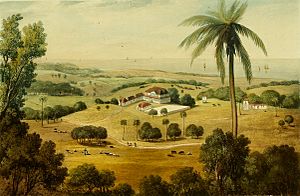Hamilton Brown facts for kids
Quick facts for kids
Hamilton Brown
|
|
|---|---|
| Born | 1776 |
| Died | 18 September 1843 (aged 66–67) British Jamaica
|
| Occupation | planter, politician |
| Known for | Founding Hamilton Town |
Hamilton Brown (1776 – 18 September 1843) was an important person from Ireland who moved to Jamaica. He became a planter (someone who owns and manages large farms) and a politician (someone involved in government). He represented Saint Ann Parish in the House of Assembly of Jamaica for 22 years. Brown also founded the town of Hamilton Town in Saint Ann Parish, which was named after him.
Contents
Early Life of Hamilton Brown
Hamilton Brown was born in 1776 in County Antrim, Ireland. He came from an Ulster-Scots family who followed the Presbyterian faith.
Hamilton Brown's Career in Jamaica
Hamilton Brown started his working life as a bookkeeper (someone who keeps financial records) for an estate. Over time, he gained a lot of land and became very involved in farming in the British colony of Jamaica.
Farming and Land Ownership
Brown was a pen-keeper, meaning he raised cattle. He was in charge of a big cattle fair held in Saint Elizabeth Parish in 1829. He also grew sugar on his farms. He owned several large farms called plantations, including Antrim, Colliston, Grier Park, and Minard, all located in St Ann. He also had a share in many other plantations.
Founding Brown's Town
Hamilton Brown founded a settlement that was first known as Hamilton Town. This town was later named Brown's Town after him, and it is located in St Ann. In 1805, he paid for the building of the original St Mark's Anglican Church in Brown's Town.
Role in Government
In 1820, Hamilton Brown became a member of the House of Assembly of Jamaica. This was like being a member of the government's parliament. He represented Saint Ann Parish in this assembly for 22 years, helping to make decisions for the colony.
Slavery and Compensation
Hamilton Brown was a slave owner in Jamaica. After the Slavery Abolition Act 1833 ended slavery in the British Empire, the British government paid money to former slave owners as compensation (payment for a loss). This was done through the Slave Compensation Act 1837.
According to the Legacies of British Slave-Ownership at the University College London, Hamilton Brown received a large payment. He was linked to 25 different claims and owned 1,120 enslaved people. Most of these people worked on sugar plantations in Saint Ann Parish. He received £24,144 at that time, which was a very large sum of money.
Bringing Irish Workers to Jamaica
Brown was also active in trying to get people from Ireland to come and work in Jamaica. In December 1835, 121 people from Ballymoney, Ireland, traveled from Belfast to Jamaica on a ship called the James Ray. This ship was owned by Brown. These Irish workers settled in St Ann. In 1836, he brought another 185 Irish people to Saint Ann.
Death
Hamilton Brown passed away on 18 September 1843. He was buried in the Protestant graveyard of St Mark's Anglican church in Brown's Town, Jamaica.


